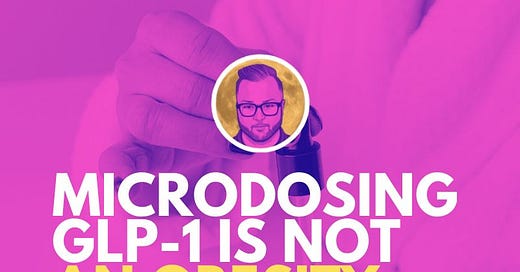Microdosing GLP-1 is Not an Obesity Treatment
The data does not lie, higher doses lead to greater weight loss
Clarification: For purposes of this article, I was speaking of microdosing as: “a fractional amount of the lowest commercially available dose, once weekly”.
There is a growing trend among telehealth companies to offer custom dosing and personalized formulations of GLP-1 medications. For some patients, especially those who are generally metabolically healthy or just beginning treatment, that flexibility could be very useful. But this shift has also helped fuel a rising and concerning narrative, often shaped by influencers, that microdosing these medications is a valid weight loss strategy for people living with the disease of obesity.
Generally, it is not. Let’s look at the science that makes that clear.
In the SELECT trial for Wegovy, the full 2.4 mg dose of semaglutide was used. That is the dose that delivered an average fifteen percent body weight loss. That is the dose that produced a twenty percent reduction in major cardiovascular events. Not a quarter dose. Not something to take the edge off. The full dose.
In the SURMOUNT-1 trial for Zepbound, participants on 5 mg of tirzepatide lost around sixteen percent of their body weight over seventy-two weeks. Those on the full 15 mg dose lost more than twenty-two percent. That is not a subtle difference. That is dose response in action.
So how did we get here? How did just a touch of a GLP-1 start being promoted like it could replace real treatment?
Let’s give credit where it is due. Dr. Tyna Moore was the first to bring attention to this concept, and she deserves recognition. She has been on my podcast, and I have been on hers. When she began discussing the idea of microdosing GLP-1s, she was not pitching it as a weight loss tool. She was speaking to metabolically healthy individuals who might benefit from the anti-inflammatory or appetite effects of these medications without requiring the full dose. And she made that distinction clear. In fact, she spoke all about it with me on this episode here:
But the internet did what the internet does by taking a thoughtful, well-formulated idea from Dr. Tyna, and turning it into something it was never meant to be.
It is not a treatment for clinical obesity.
Obesity is not a vibe. It is not something you lightly adjust. It is a disease with deep roots in biology, the brain, and hormones. And the clinical trials, not the marketing, show what actually works.
If you are living with obesity, you deserve care that is grounded in evidence. The studies that produced life-changing results did not use microdoses. They used real, therapeutic levels. The kind that move the needle.
Microdosing likely has a place for those who are already metabolically healthy and just looking for support. But for those of us fighting obesity, it is likely not enough.
The results are dose dependent.
A little plug for OTP’s amazing partners at Ro: Cash pay Zepbound vials (2.5mg-10mg) and $199 introductory Wegovy (all doses) are available through our partners at Ro right now, seamlessly through their app.







Well….I have to respectfully disagree with the “evidence.” Some of us are super-responders and have lost all of the excess weight on the lowest dose of Zepbound. I know I’m in the minority, but that’s why we need for our practitioners to have the ability to tailor dosages with compounds. In 41 weeks, I’m down 62 pounds and only on 2.5 mg bc they don’t make a lower dose. I am no longer pre-diabetic, hypertensive, and full of arthritis pain. I would go to a lower dose if I could because I still have some unpleasant side effects. I know there are many others like me because I’ve seen their posts on other social media platforms.
I think a whole post needs to be done to explain the difference between Microdosing, split dosing and divided dosing, compared to minimum dose dosing.
Example: I divide my 15mg dose of Zepbound into three 5mg doses and take it on a Monday, Wednesday, Friday schedule totaling 15mg weekly.
There are a lot of people dividing their doses up, because it reduces the severity of the side effects. But, they are calling it Microdosing, when in actuality it is divided or split dosing. But they hear the Influencers and others say the word Microdosing so they think that’s what they are doing.